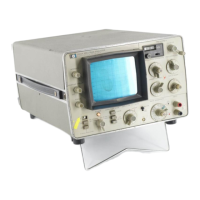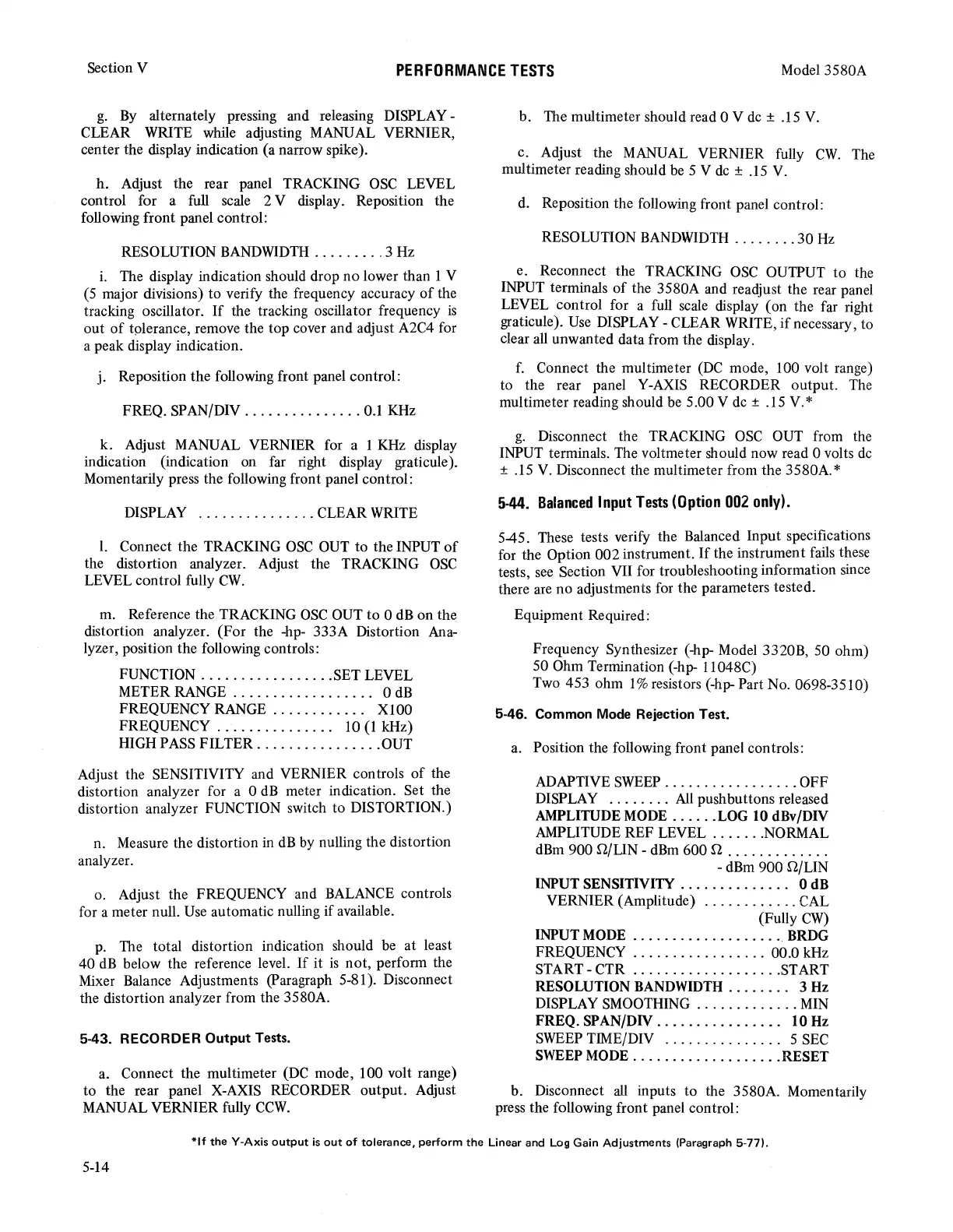Section V
PERFORMANCE
TESTS
Model 3580A
g.
By alternately pressing and releasing DISPLAY -
CLEAR WRITE while adjusting MANUAL VERNIER,
center the display indication (a narrow spike).
h.
Adjust the rear panel TRACKING
OSC
LEVEL
control for a full scale 2 V display. Reposition the
following front panel control:
RESOLUTION BANDWIDTH
.........
3 Hz
i. The display indication should drop
no
lower than 1 V
(5
major divisions)
to
verify the frequency accuracy
of
the
tracking oscillator.
If
the tracking oscillator frequency
is
out
of
tolerance, remove the top cover and adjust A2C4 for
a peak display indication.
j.
Reposition
the
following front panel control:
FREQ. SPAN/DIV
...............
0.1 KHz
k. Adjust MANUAL VERNIER for a 1 KHz display
indication (indication on far right display graticule).
Momentarily press the following front panel control:
DISPLAY
...............
CLEAR WRITE
l. Connect the TRACKING
OSC
OUT
to
the INPUT
of
the distortion analyzer. Adjust the TRACKING
OSC
LEVEL control fully
CW.
m. Reference the TRACKING
OSC
OUT
to
0 dB
on
the
distortion analyzer.
(For
the -hp- 333A Distortion Ana-
lyzer, position the following controls:
FUNCTION
.................
SET LEVEL
METER RANGE . . . . . . . . . . . . . . . . . . 0
dB
FREQUENCY RANGE . . . . . . . . . . . .
XlOO
FREQUENCY
...............
10
(1
kHz)
HIGH PASS FILTER
................
OUT
Adjust the SENSITIVITY and VERNIER controls
of
the
distortion analyzer for a 0
dB
meter indication. Set the
distortion analyzer FUNCTION switch
to
DISTORTION.)
n. Measure the distortion in
dB
by nulling the distortion
analyzer.
o. Adjust the FREQUENCY and BALANCE controls
for a meter null. Use automatic nulling
if
available.
p. The total distortion indication should be at least
40
dB
below the reference level.
If
it
is
not,
perform the
Mixer Balance Adjustments (Paragraph 5-81). Disconnect
the distortion analyzer from the 3580A.
5-43. RECORDER
Output
Tests.
a. Connect the multimeter (DC mode, 100 volt range)
to
the rear panel X-AXIS RECORDER
output.
Adjust
MANUAL VERNIER fully
CCW.
b. The multimeter should read 0 V
de±
.15 V.
c. Adjust the MANUAL VERNIER fully
CW.
The
multimeter reading should be 5 V
de±
.15 V.
d. Reposition the following front panel control:
RESOLUTION BANDWIDTH
........
30
Hz
e. Reconnect the TRACKING
OSC
OUTPUT
to
the
INPUT terminals
of
the 3580A and readjust the rear panel
LEVEL control for a full scale display
(on
the far right
graticule). Use DISPLAY - CLEAR WRITE,
if
necessary, to
clear all unwanted data from the display.
f.
Connect the multimeter
(DC
mode, 100 volt range)
to the rear panel Y-AXIS RECORDER output. The
multimeter reading should be 5.00 V de ± .15 V. *
g.
Disconnect the TRACKING
OSC
OUT from the
INPUT terminals. The voltmeter should now read 0 volts
de
± .15
V.
Disconnect the multimeter from the 3580A. *
5-44.
Balanced
Input
Tests
(Option
002
only).
545.
These tests verify the Balanced
Input
specifications
for the Option
002
instrument.
If
the
~nst:nment
f~s
t~ese
tests
see
Section VII for troubleshootmg mformation smce
ther~
are
no
adjustments for the parameters tested.
Equipment Required:
Frequency Synthesizer (-hp- Model 3320B, 50 ohm)
50 Ohm Termination (-hp- 11048C)
Two 453 ohm
1%
resistors (-hp-Part No. 0698-3510)
6-46. Common Mode Rejection Test.
a. Position the following front panel controls:
ADAPTIVE
SWEEP
.................
OFF
DISPLAY . . . . . . . . All pushbuttons released
AMPLITUDE MODE
......
LOG 10 dBv/DIV
AMPLITUDE REF LEVEL
.......
NORMAL
dBm 900 Q/LIN - dBm 600 n
............
.
- dBm 900 Q/LIN
INPUT SENSITIVITY . . . . . . . . . . . . . . 0 dB
VERNIER (Amplitude)
............
CAL
(Fully
CW)
INPUT MODE
...................
BRDG
FREQUENCY
.................
00.0 kHz
START-CTR
...................
START
RESOLUTION BANDWIDTH . . . . . . . . 3 Hz
DISPLAY SMOOTHING
.............
MIN
FREQ. SPAN/DIV
................
10 Hz
SWEEP TIME/DIV . . . . . . . . . . . . . . . 5 SEC
SWEEP MODE
...................
RESET
b. Disconnect
all
inputs to the 3580A. Momentarily
press the following front panel control:
*If
the
Y·Axis
output
is
out
of
tolerance,
perform
the
Linear and Log Gain
Adjustments
(Paragraph 5-77).
5-14

